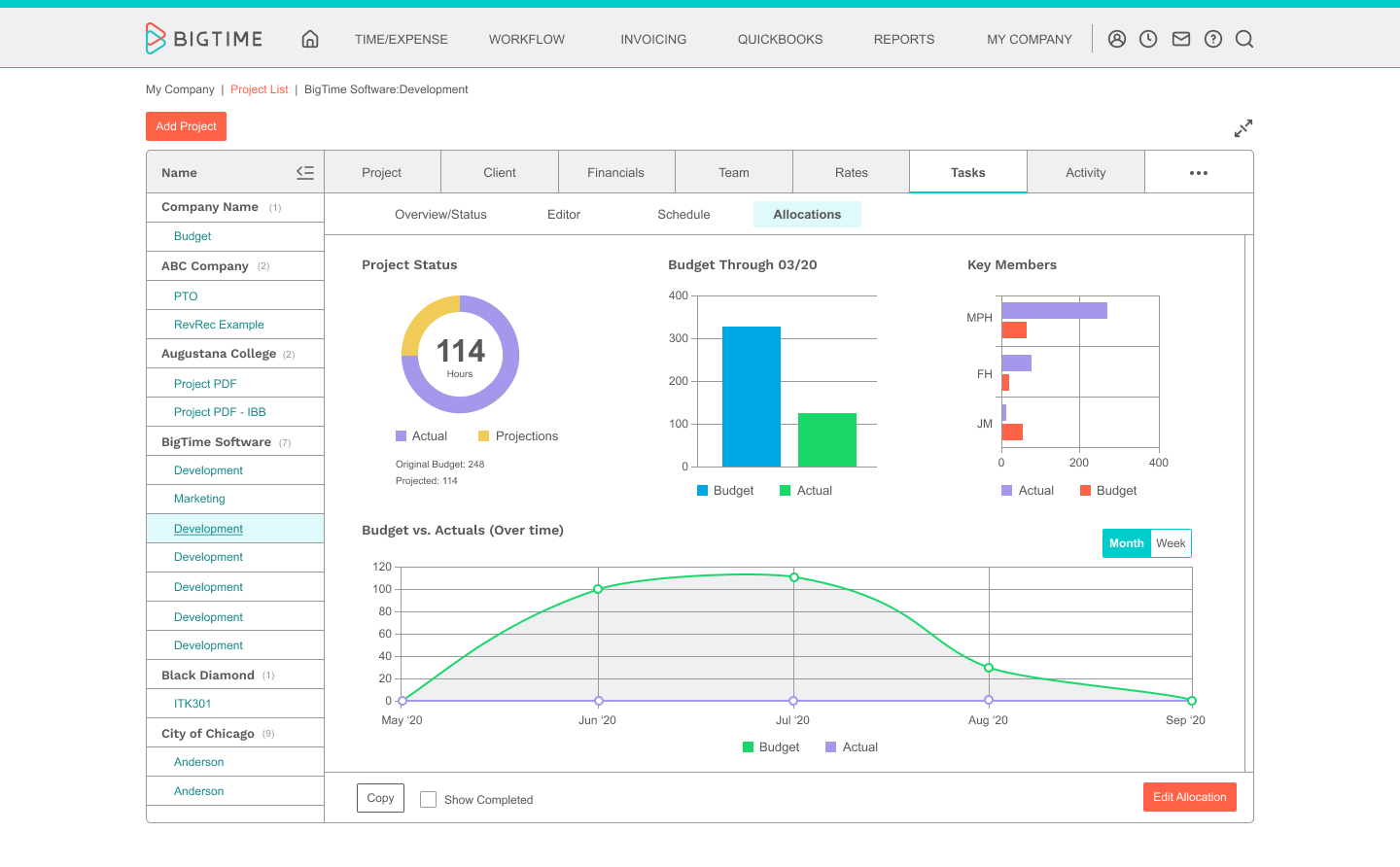Capacity Planning Tool
Avoid over/under utilization with software designed to manage your firm's resources in real-time.
SHOW ME HOW
Track smarter, not harder
Easily log time and expenses with personalized data entry options for your team's individual timesheets.
Bill fast and friendly
Quickly pull together professional-looking custom invoices and send to your clients without the hassle.
Avoid over/under scheduling
Always have an idea of you who working on what and reduce overall time on the bench.
Keep projects moving
Smoothly handoff work between teams and approval levels with custom workflows so you can manage your projects you way.
Plan ahead and on the fly
See your plans and analyze progress at a glance with dashboards, analytics, and reporting.
Connect your favorite tools
Seamlessly sync your current software with our deep integrations and full tech support from our team.
Better growth starts here.
LEARN MORE
When managing a project, companies entrust managers to effectively delegate the various tasks to certain employees and departments, ensuring each individual or team can handle their assigned tasks. As new projects arise, project managers must turn to their team to ensure they meet a project’s timeline. To do this, they often equip themselves and their team with tools to help streamline the process. Having the proper tools in their tool belts help project managers plan and facilitate projects accordingly.
Capacity planning tools can help you get a better grasp on project management, allocating resources, and streamlining efficiency. Understanding each team or individual’s capacity can help prevent over-assigning (or under-assigning). Over-assigning people with tasks can cause bottlenecking and other delays, as team members have bitten off more than they can chew. On the contrary, you may be spending unnecessary funds by underutilizing your resources, causing people to complete less work than they can.
Whether the projects involve marketing, operations, or manufacturing, capacity planning tools are helpful when looking at the bigger picture. As a project progresses, unpredictable events can arise. When this occurs, it is up to project managers to play out the best course of action. Resource capacity planning tools can provide an overview of a project's tasks and timeline, allowing project managers to review such things and adapt accordingly. For example, a project manager can see if one area of a project is slowing down while another is moving quickly and reallocate resources accordingly.
With BigTime's tools, such as network capacity planning templates, managers can foresee the workloads of project staffers and assign tasks as they see fit. As projects reach specific milestones, managers can reassess and determine future assignments. Team members can document their hours worked, and with that two-way communication comes a more optimistic project team.
Network capacity planning tools and open-source capacity planning tools from BigTime help project managers monitor milestones and meet deadlines, all while maintaining a comfortable assignment count for team members. With these tools, managers can mitigate bottlenecks from over-assigning and combat wasting and overspending resources from under-assigning.
Microsoft Capacity Planning Tools
Several other companies, such as Microsoft, also have capacity planning solutions to help project managers remain on track and monitor resources. Each has unique features, some being more robust than others. Some can even be integrated with capacity planning tools by Jira. Even the more straightforward, less complex options are still effective nonetheless.
Microsoft Planner is an elementary, easy-to-use planning application as part of the Microsoft 365 cloud. This simple platform is great for smaller projects, allowing team members to stay organized, collaborate, and share files with one another. You can also break down projects and assign tasks to respective individuals.
Microsoft Team Planner is dedicated for use on Microsoft Teams. Capacity planning for projects can be facilitated with Microsoft Teams Planner, as team members can track their tasks and be alerted when new ones are assigned.
Microsoft Planner Resource Management, an oldie but goodie, is one of the more powerful capacity planning solutions available. It has an extensive array of abilities and is not for the faint of heart. Working with this tool requires full-on dedication and is not suited for smaller tasks. It is one of the more effective planning tools by Microsoft. Project capacity planning via developing a schedule, assigning resources to tasks, tracking progress, managing a budget, and analyzing workloads are some ways Microsoft Planner Resource Manager outweighs other solutions.
Aside from the aforementioned planners, Microsoft also has a variety of project capacity planning templates in Excel, which we discuss further below.
Capacity Planning Tools Excel
You find that excel is a crucial tool that coincides with capacity planning tools. Excel has several different templates and worksheets that assist in simple capacity planning. Excel's features are often available for free or as part of a subscription.
One of the many features of Excel is a team capacity planning template. With this template, you can organize your team in a roster-style list, mapping out each team member with their respective tasks. It can help assess future capacity projections and provides an overview of team assignments. There are manufacturing capacity planning excel downloads and other resource capacity planning Excel templates available to simplify capacity planning with Excel.
Excel also offers Agile resource capacity planning templates that can be used in conjunction with Scrum for Software Development. Since Software Development is meticulous, Scrum simplifies this with incremental processes and cross-functional teams to leverage meeting project goals.
It is up to project managers to arm themselves with quality tools for an effective capacity planning formula. In Excel, while it has its perks, there are a number of features that require a more advanced skill level of the program. The available templates, while helpful, are not final and must be customized accordingly to better reflect the capacity planning needs of a company. Excel spreadsheets are very labor-intensive and require a very detail-oriented individual to manage. They are heavily dependent on data entry and formulas, so having a single individual with the attention to detail and knowledge of Excel is helpful to avoid potential hiccups.
Capacity Planning Tools Jira
BigTime is one of the many Agile capacity planning that integrates with Jira. With the Jira capacity planning plugin and BigTime’s custom reporting capabilities, Agile planning staff can sync and manage their project assignments in a comprehensive and clean user interface.
With Jira, capacity planning story points for software development is a breeze. You can create Agile user personas to determine the wants and needs of potential users. Capacity planning story points are the milestones in hours a development team can complete. Software developers use story points to drive project progression as they get in the minds of their users.
Jira has a Sprint Capacity calculator that tracks the fixed amount of time allocated to development cycles for teams. Capacity planning becomes less stressful with the time allotments, so teams know what tasks need to be completed and when. Project managers can also see where project proceedings are delayed or lacking. They can then make informed decisions and hire staff accordingly to fulfill skills gaps, task loads, or any other reason for delays.
Bridging these gaps with new employees or staffers can easily ensure project goals and deadlines are met. Jira capacity planning Excel templates allow for easy integration and help facilitate project management.
Resource Capacity Planning Tool
The best capacity management tools should provide clear project status and task visibility. Easy-to-use capacity planning software like BigTime depicts a clear picture of project phases, staff assignments, and resource allocation. With this clarity, project managers can ensure their teams are engaged with a comfortable workload.
Effective resource planning cannot be done without a resource capacity planning tool. Excel and capacity planning software offer integrations with capacity management tools for a more seamless tracking experience. With these tools in your project management tool belt, you, as a project manager, can ensure your team meets deadlines, balance their assignments, and meet budget needs.
There are several types of capacity planning tools, each with different features to help simplify project management and ensure tasks are completed according to their assigned deadline. Using capacity planning tools such as BigTime can help combat common problems in capacity planning. In supply chain management, for example, bottlenecking is a common issue. Finding out where the bottleneck is occurring can help managers determine if additional staff need to be hired and what essential skills those new workers should have.
Resource Capacity Planning
Overall, resource capacity planning is an essential function for project managers. The process of capacity planning does not need to be tedious. In fact, a number of tools are available to ease the burdens that accompany capacity planning. Example problems relevant to capacity planning heavily relate to data collection and quality.
Capacity planning utilizes abundant data and formulas to determine budgeting needs and personnel resources. Managers can then make data-driven decisions about staffing and funding or reallocate resources as they see fit. Since capacity planning is highly driven by data, ensuring managers use high-quality data to make decisions is crucial. Relying on labor-intensive, manual data entry invites the opportunity for errors, impacting the quality of the data. Project managers can make bad decisions if they are based on data that is not accurate.
Using capacity monitoring tools ensures assignments are met by the entire project workforce. Capacity planning tools like BigTime help streamline the pitfalls that accompany capacity planning. Examples of capacity planning tools include Microsoft Planner, Microsoft Excel, and Jira. BigTime can be integrated with these programs to help assist in time and budget planning.
As projects become more time and labor-consuming, project managers should ensure they have the proper tools to help their teams (and themselves) get things done. Completing projects is a group effort, and it’s important that each group member feels they are adequately performing each project task to the best of their abilities. Capacity planning is a great way to make sure that happens.



